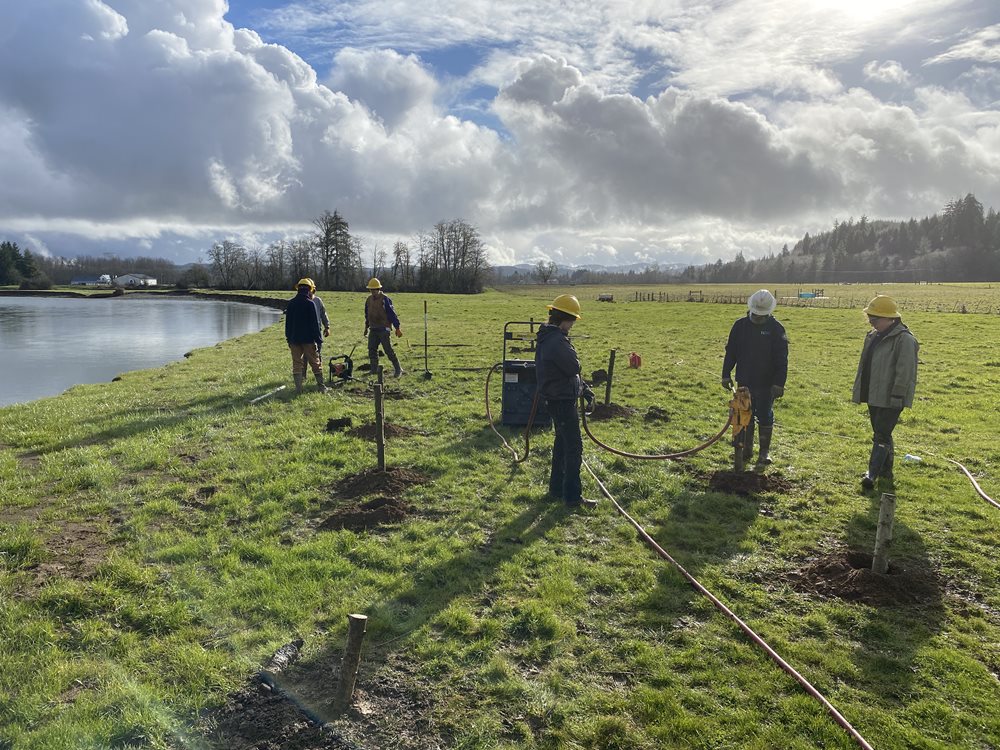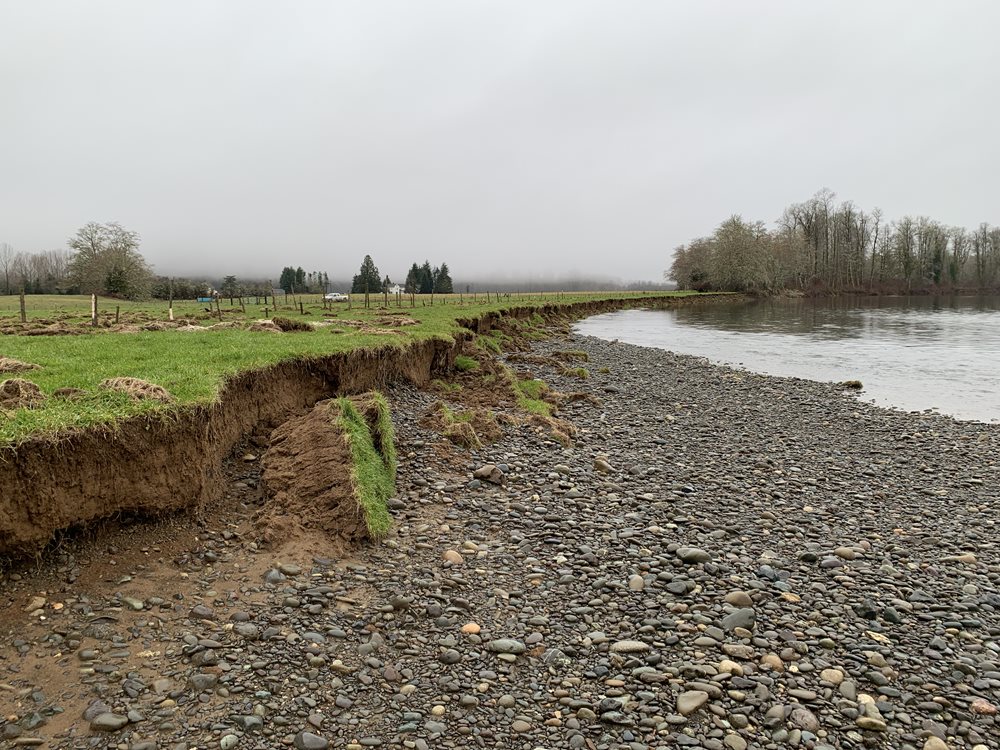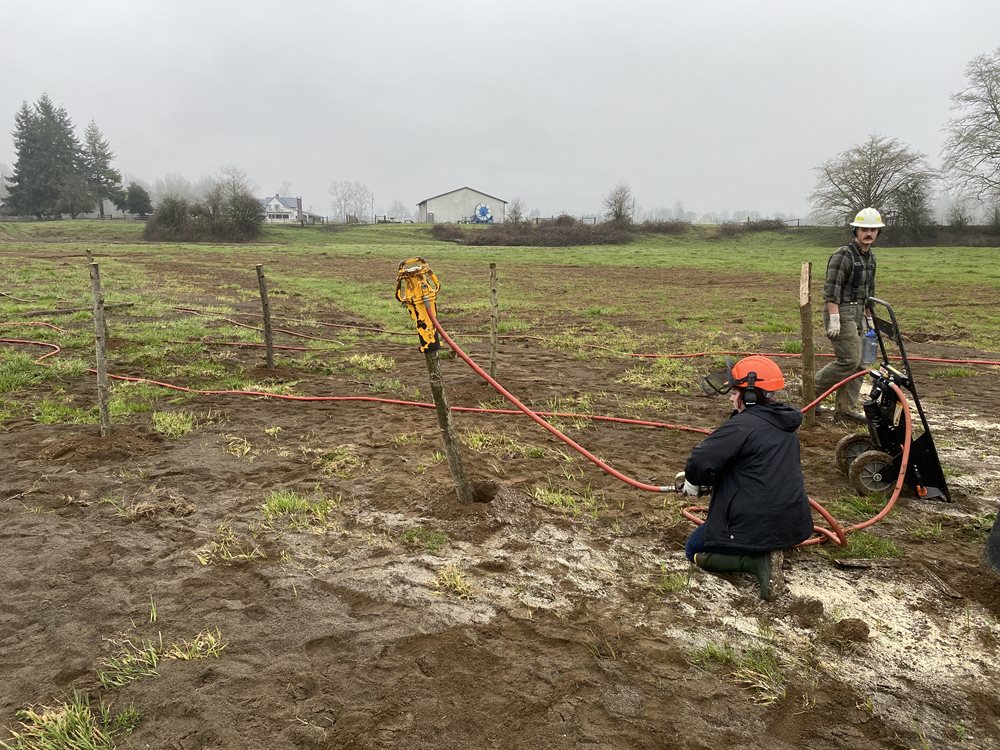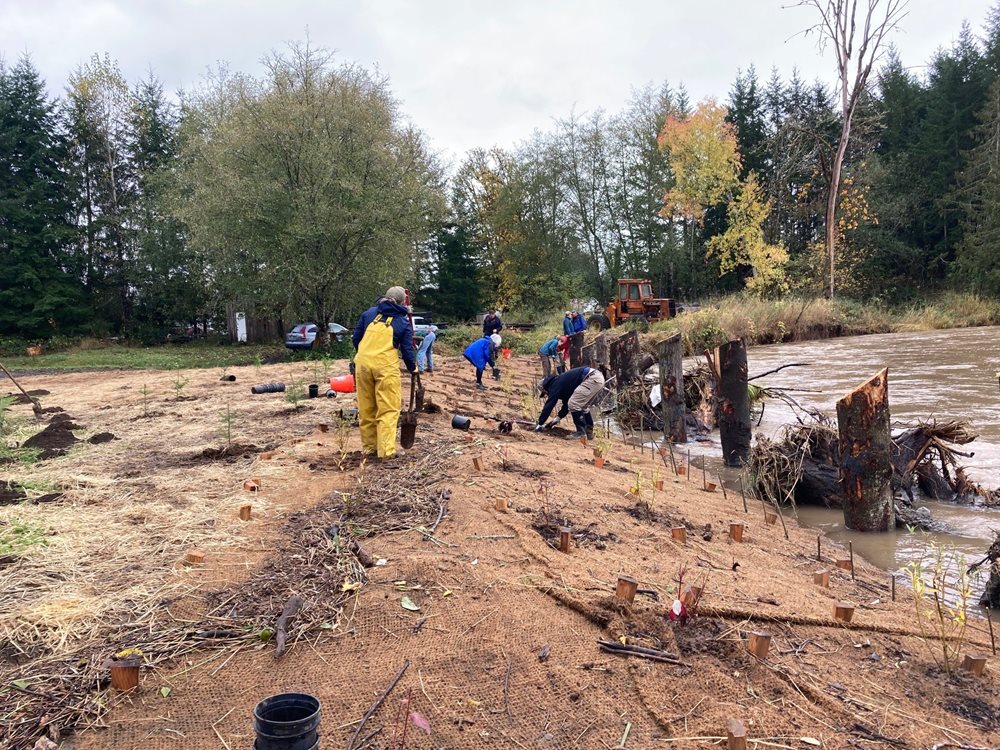
Since 2013, the Office of Chehalis Basin (OCB) has invested $98.8 million for 39 projects to reduce flood-related damage and 68 projects to restore aquatic species habitat in the Chehalis River basin.
There are eight other basin projects that have dual flood-reduction and ecosystem benefits. For these integrated projects, OCB has invested $1.6 million to acquire property, develop a streamflow gauge plan, create a demonstration project to test how groundwater and surface waters mix, and manage erosion.
In Grays Harbor and Lewis counties, two completed erosion-management pilot projects are:
- Satsop River Mile 3.5 to 4.0 Erosion Reduction Pilot
- State Route 508 Erosion Reduction Pilot
Satsop River Mile 3.5 to 4.0 Erosion Reduction Pilot
Just outside of Brady, along a two-mile stretch of the Satsop River, the Grays Harbor Conservation District has been working with landowners since 2020 on an aquatic-species restoration project. The project is funded by the Chehalis Basin Strategy’s Aquatic Species Restoration Plan, or ASRP, and involves planting riparian vegetation and installing engineered log jams to increase habitat complexity, connect floodplains, and slow erosion. Due to the large scale of the overall plan, design and permitting can take multiple years until construction is able to proceed. Further construction is expected in summer 2023 and 2024.
Once complete, the ASRP project will primarily benefit four species of salmonids, but the increased habitat complexity will also benefit amphibians, waterfowl, and other native fish. Unfortunately, bank erosion in the project river reach has been progressing aggressively for decades, sometimes at more than 100 feet per year.
Since 1991, one of the main project landowners has lost approximately 30 acres of riparian forest and farmland, causing irreversible flood damage to their farm and increasing risk to their home. While the ASRP project will address the erosion, the district developed an erosion management pilot project to begin to slow it sooner.
The $14,600 project, funded by the Chehalis Basin Strategy, created an “instant” riparian buffer using six-foot- to 10-foot-long native cottonwood and willow live poles. The 350 poles were installed in two rows parallel to the bank in February 2022 by the district crew and a Washington Conservation Corps crew of five.
The team used a motorized augur to create pilot holes, and then used a pneumatic post pounder to drive the poles anywhere from three feet to eight feet down.
“We used these techniques so that we could get them as deep as possible, to hopefully get roots establishing throughout the potential erosion zone,” noted Anthony Waldrop, the project manager from the district. “Depth also makes the live poles more resilient to summer drought conditions, as their roots can access deeper groundwater.”
Cottonwoods and willows are used in many river-restoration projects, due to their ability to propagate from live cuttings and establish root systems quickly in highly dynamic river environments. Using cuttings mimics their natural adaptation of colonizing flood-disturbed areas from branches that have broken off from existing cottonwood and willow plants. Due to the rate of erosion on this property, the district decided to use larger and longer live cuttings. Installing them deeper than a typical live-cutting project has also helped to more quickly jumpstart erosion reduction.
Over the course of almost a year, the project continues to be monitored closely. As of September 2022, about 80% of the installed poles have survived. Live-cutting survival, according to Waldrop, was largely driven by access to water.
“All of the poles did well initially during the wet spring, but as the soil dried out, those that were only driven three feet into the ground had trouble surviving during the summer drought. Poles that were deeper, however, were able to thrive with access to water all summer long,” he said.
Additional interesting results include:
- Poles driven at least four feet into the ground were the most successful at surviving and thriving. Some poles were quite vigorous, putting on close to 10 feet of new growth in one season.
- Poles were able to compete with aggressive non-native weeds such as reed canary grass, without any maintenance needed.
“A key takeaway,” Waldrop said, “is that, so far, this is a cheap and effective technique for rapidly establishing a vigorous riparian forest without maintenance or watering. Additional time is needed to determine if the added root-cohesion is enough to significantly slow erosion in this reach.”
Maintenance and monitoring of this pilot project will continue through spring 2023.
State Route 508 Erosion Reduction Pilot
In March 2022, a property on state Route 508, near river mile 18.5, was identified as a high priority because of its proximity to the South Fork of the Newaukum River. Aggressive erosion had been threatening damage to the home. Also known as the MacBryer Project, OCB worked with the Lewis County Conservation District on a plan to act fast to save this home.
“We looked at seven sites, and three of them were determined to be in imminent danger for different reasons,” said Bob Amrine, project coordinator for Lewis Conservation District. “One site had encroachment on the septic system, one site was where the river was right next to state Highway 508, and the other site was the MacBryer site, where the house was determined to be in imminent danger,” he said.
According to Amrine, the South Fork of the Newaukum River had moved 15 or 20 feet in the last year and had moved over 100 feet in recent years, encroaching on the home.
Homeowner David MacBryer noticed the issue a couple of years ago. “The bank started disappearing,” he said. “We’ve lost over 40 feet in six years.”
During the March 2022 site assessment, OCB identified the primary causes of the erosion and targeted potential mechanisms to deflect erosive flows and trajectory for future flows and erosion. Starting in April and continuing through the summer and fall, OCB approved a project design, secured $168,000 in funding, obtained the necessary permits, and completed construction.
OCB offered the Lewis Conservation District a grant to get a conceptual design, final design and permits, and to construct the project, Amrine said.
In September and October, contractors and engineers constructed engineered log structures known as “cribwall jams” with tree trunks and timber piles that were embedded 8-11 feet; regraded the upper bank of the river; installed erosion-control coir fabric and live willow fascines; and prepared the site for vegetative plantings.
With the Lewis County Stream Team, the district planted 25 potted willows, 25 red osier dogwoods, 10 western red cedars, 10 Douglas firs, and 100 willow stakes in November 2022.
This fast-paced project is complete and is now in the monitoring stage.
“We are watching it close during high-water events, and the log cribwall seems to be functioning as designed,” Amrine said. “We have a 10-year agreement with Mr. MacBryer, and if he sees anything that looks like the project is in danger, he will call us, and we will attempt to assist at that time. Hopefully, this does not happen.”
MacBryer has been keeping an eye on the project site, noting that the firs are taking, and the willows are sprouting, but the cedars are struggling.
“We [recently] had that one major rainstorm, and we never got any water up on the land at all,” he said.
Regarding his overall feelings about the project, MacBryer said, “It was very satisfactorily done.”





